August 5th, 2010 at 7:02 pm (Productivity, Psychology)
Wikipedia has an entry describing burnout, specifically in the work context. (It’s not really relevant how I ended up there. Right.) I learned that there is a “well studied measurement of burnout” called the Maslach Burnout Inventory. It makes use of a “three dimensional description of exhaustion, cynicism, and inefficacy”. Maslach originally characterized burnout for professions such as psychology and social work, in which those experiencing burnout can not only be ineffective but start to view their patients or clients in a depersonalized or dehumanized way. But anyone in any profession can suffer ill effects from reaching unbearable levels of frustration and exhaustion. A later study showed that the MBI had “sufficient fit” as a descriptive/diagnostic tool for various occupations, except for those in advertising (hm?).
While the MBI itself is only available by purchase, you can take a quick self-test to get an idea of your burnout level (if it isn’t already obvious to you). The same site also provides tips on avoiding burnout. The one that resonated most with me was advice to “protect the parts of your job that give you meaning and satisfaction.” When too much of your time is swallowed up in the dreck that provides no satisfaction, but from which you cannot escape, you automatically ratchet up the burnout scale. It’s good to be reminded that taking time to focus on the parts you really enjoy benefits everyone you work with, not just you.
2 Comments
2 of 2 people learned something from this entry.
August 3rd, 2010 at 11:23 pm (Sports, Swimming)
Building on my initial success with learning to wakesurf, the following day I got some more practice and found it to be easier and easier. I’m still no pro, but I managed to stay up for an entire minute on at least one run, and I even dared to cross the wake!
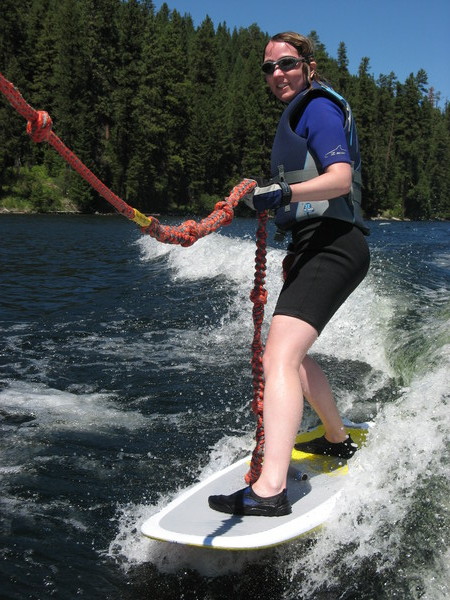
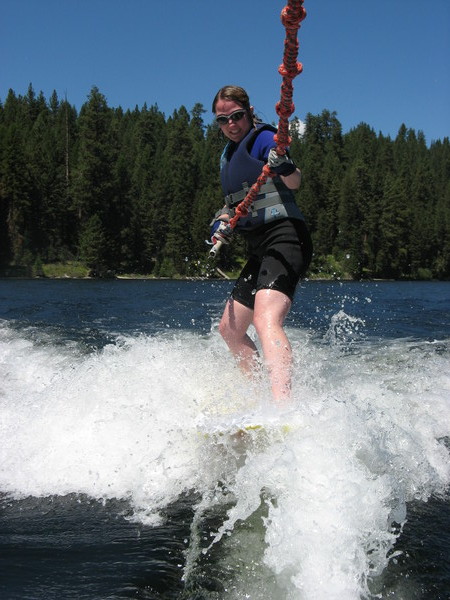
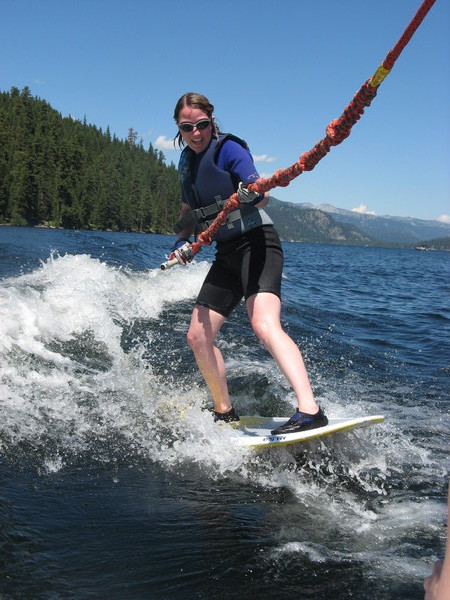
This turned out not to be as tricky as I thought. I just leaned a little back into my heels, the board climbed up onto the wake, and I held tightly to the rope while froth rushed over my ankles. Then I dipped into my heels again and the board slid down the far slope into the other side of the wake. The trick was to do all of this gradually without overcorrecting for the slope changes! My posture and confidence have both improved a bit, and I’m doing much better at keeping slack in the rope. I was even able to let go with one hand and wave at the boat!
The idea ultimately is to be able to let go of the rope entirely and just surf on the wake behind the boat. The rope isn’t really towing you anyway (except atop the wake where there’s no wave to ride down); it’s just there for balance and positional correction. I did get to see the no-rope version performed, and I’d love to get to that point myself! It’s fascinating to see the balance in forces between the rider’s weight on the board pushing down and the rush of the wake-wave curling up. But first I need to be able to start on my own… to date I’ve still had someone holding the board steady for me during those first critical seconds of getting onto the water. But I think that may be an achievable goal! No-rope wakesurfing… that’ll take a lot more practice.
1 Comments
1 of 1 people learned something from this entry.
July 31st, 2010 at 7:18 pm (Sports, Swimming)
Over the past two days, I’ve had the chance to learn how to wakesurf! Given some expert instruction and tons of assistance (i.e., holding the board steady for me initially, just like training wheels), I was able to stand up on a wakesurfer and ride the wake curl right behind the boat for a good 15 seconds!
 First we’d position the board behind the boat so that its front rested on the boarding platform and its tail hung out into the water. I learned to step onto the board with my front foot and lean my weight back out over the board, using the rope, without putting my back foot down until the boat picked up enough speed. It takes some practice to figure this out, but it seems to happen around 6 knots. At that point you can ease your weight fully onto the board (and off the platform) and slide backward, paying out rope gradually, until you’re in the wake curl. At first this felt really shaky to me, because your legs have to figure out how to absorb all of the little bumps and twists of the water while maintaining your balance. Then it started to smooth out, and I stayed up until the board shifted back a little, up onto the wake, and I lost my balance. Also, my posture in this picture could be improved by straightening my torso to make it easier to keep my weight centered over my feet and the board. But hey, not bad for ~8 attempts.
First we’d position the board behind the boat so that its front rested on the boarding platform and its tail hung out into the water. I learned to step onto the board with my front foot and lean my weight back out over the board, using the rope, without putting my back foot down until the boat picked up enough speed. It takes some practice to figure this out, but it seems to happen around 6 knots. At that point you can ease your weight fully onto the board (and off the platform) and slide backward, paying out rope gradually, until you’re in the wake curl. At first this felt really shaky to me, because your legs have to figure out how to absorb all of the little bumps and twists of the water while maintaining your balance. Then it started to smooth out, and I stayed up until the board shifted back a little, up onto the wake, and I lost my balance. Also, my posture in this picture could be improved by straightening my torso to make it easier to keep my weight centered over my feet and the board. But hey, not bad for ~8 attempts.
The goal is to get enough control and comfort that you can actually let go of the rope entirely and just surf along behind the boat. I’m nowhere near that point, but considering that the last time I was really in the water was 1.5 years ago, and that was to learn (belatedly) to swim, I’m thrilled with what I was able to do today! I doubt I’ll ever be a surfer, and I also learned today that I have no innate waterskiing skill, but I’d definitely wakesurf again. It’s fun!
5 Comments
3 of 4 people learned something from this entry.
July 30th, 2010 at 5:45 pm (Productivity, Research)
Recently at work, a new person we are hiring was described as having a high “h-index”. I had never heard of this term, so I looked it up later. The h-index is short for Hirsch index and was proposed by Jorge E. Hirsch as a method for quantitatively characterizing scientific impact through publications. It is defined as:
A scientist has index h if h of [his/her] Np papers have at least h citations each, and the other (Np – h) papers have at most h citations each.
Intrigued, I went off and calculated my own h-index, which (using citation data from Google scholar) is 12:
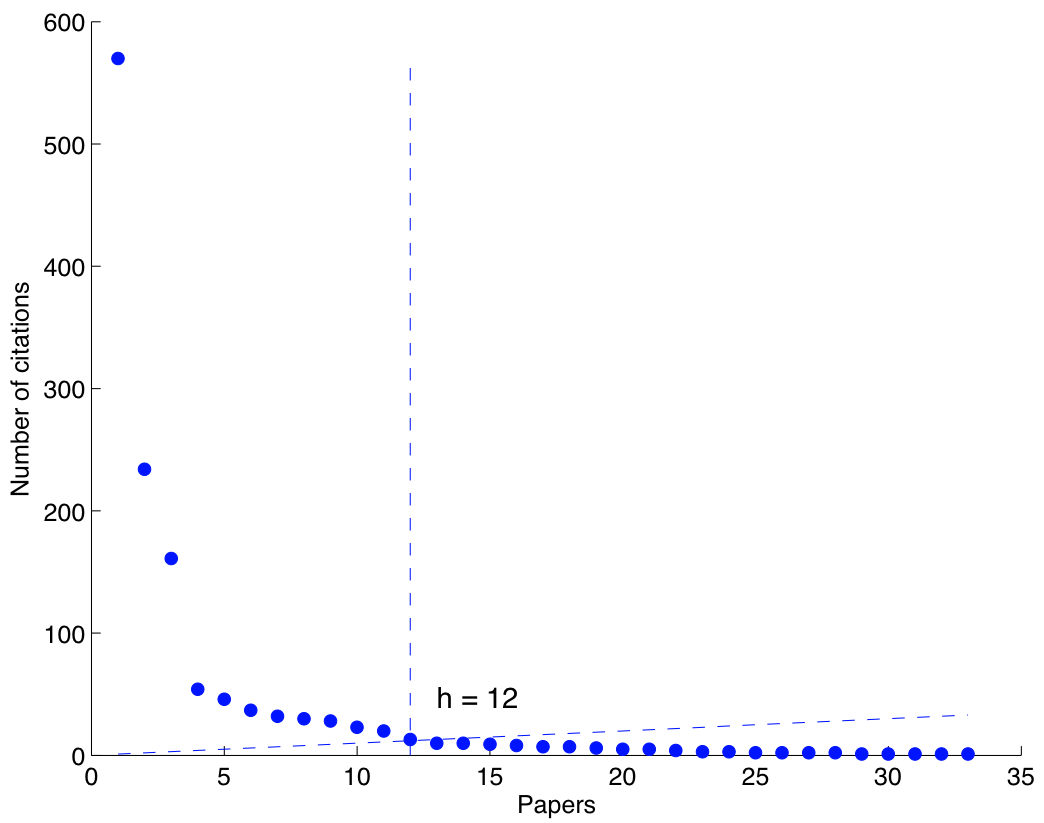
According to the wikipedia entry on the h-index, that’s a decent score for use in “tenure decisions”, while getting up to about 18 might rate a full professorship. Of course, this is a coarse metric with (like all other simple metrics) its drawbacks. It doesn’t factor in the number of other authors on the paper, or whether the citations are self-citations, or how the paper is cited (in a substantive manner vs. a member of a long list of work cited in the introduction). But who doesn’t enjoy a moment of quantitative navel-gazing? Calculate away!
4 Comments
1 of 2 people learned something from this entry.
July 27th, 2010 at 10:11 pm (Crafts)
The next Netflix movie I watched after MirrorMask was Lawrence of Arabia. Wow, what a movie! It leaves an enduring impression due to its sweeping desert vistas, its portrayal of the quirky, passionate, (slightly mad?) character of T. E. Lawrence, and its length. I learned a lot about WWI that I didn’t previously know, such as the role of the Arabs in the conflict.
And in honor of this great movie, I learned how to fold an origami camel. Check it out!
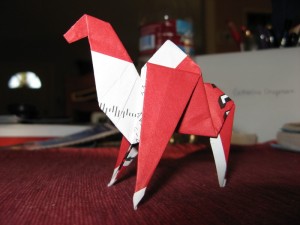
4 Comments
2 of 3 people learned something from this entry.





